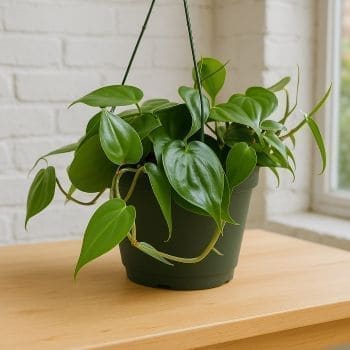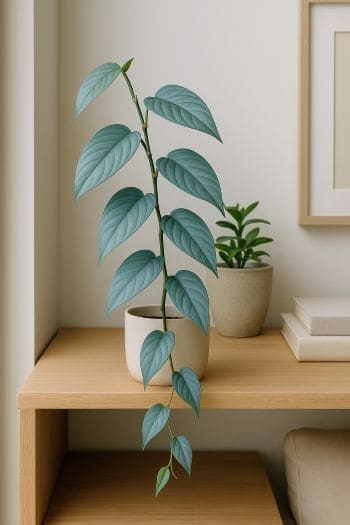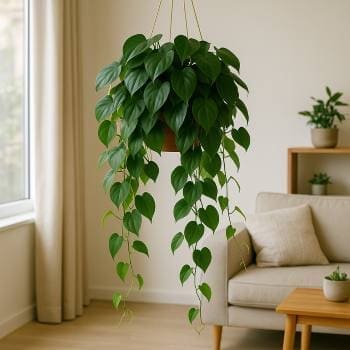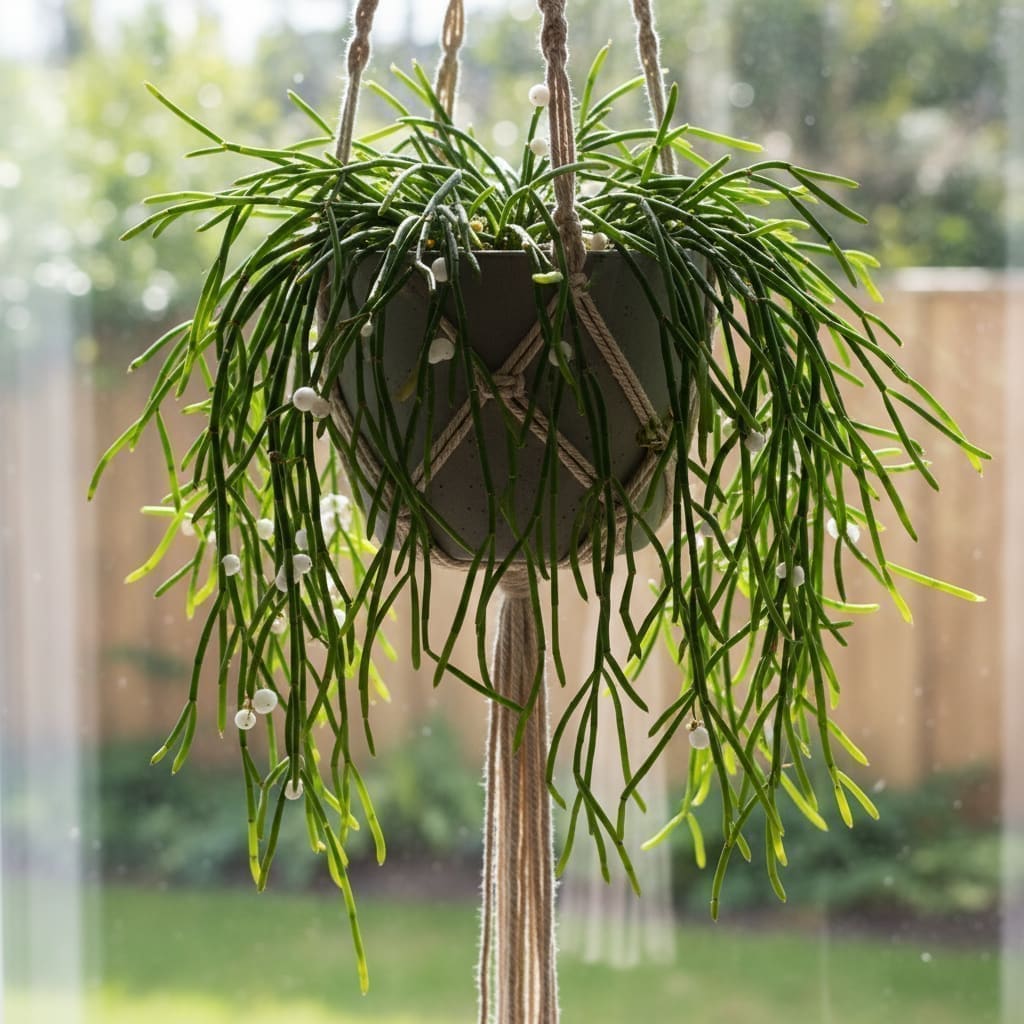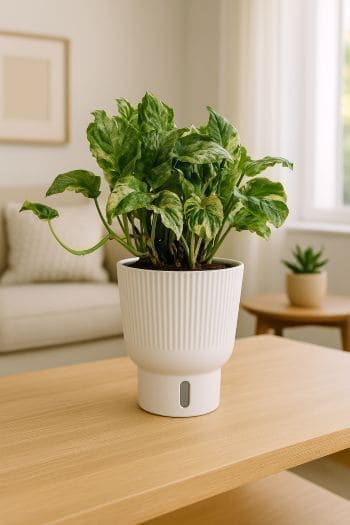Philodendron cordatum Care & Growing Guide
Overview
Philodendron cordatum is a trailing and climbing tropical plant native to the southeastern coastal regions of Brazil. Known for its heart-shaped green leaves and adaptable nature, this species is popular as a houseplant for both beginners and experienced indoor gardeners. In its native habitat, it can grow as an epiphyte on trees or epilithically on rocks, taking advantage of the warm, humid climate. Indoors, it thrives in medium to bright indirect light and requires moderate watering, making it a low-maintenance yet lush addition to living spaces.
Identification & Growth Habit
This philodendron produces slender, vining stems with smooth, glossy, heart-shaped leaves that can reach 2–4 inches in indoor conditions, and larger in the wild. The plant’s natural growth habit is trailing or climbing, making it ideal for hanging baskets, shelves, or trained up a moss pole or trellis. When given vertical support, the leaves may grow larger and more mature in shape.
Light & Placement
Philodendron cordatum thrives in medium to bright indirect light but can adapt to lower light levels. Avoid prolonged direct sunlight, which can scorch leaves. Place the plant near an east- or north-facing window for gentle light, or a few feet back from a bright south- or west-facing window with filtered light. In low light, growth will slow and internodes may elongate, but the plant will usually remain healthy.
Watering & Humidity
Water when the top inch of soil feels dry to the touch. Use room-temperature water and allow excess to drain freely. Overwatering can lead to root rot, so ensure the pot has drainage holes. Maintain moderate to high humidity—ideally above 50%. If your home is dry, especially in winter, increase humidity with a humidifier, pebble tray, or by grouping plants together.
Soil & Repotting
Use a well-draining potting mix rich in organic matter. A blend of peat moss, perlite, and standard houseplant soil works well, allowing moisture retention without waterlogging. Repot every 1–2 years in spring when roots become crowded or growth slows. Choose a pot 1–2 inches larger in diameter than the current one to prevent excessive soil moisture retention.
Fertilizing
Feed with a balanced liquid fertilizer diluted to half strength every 4–6 weeks during the active growth period (spring and summer). Reduce or suspend feeding in fall and winter when growth naturally slows. Over-fertilizing can cause salt buildup and leaf tip burn, so flush the soil with plain water occasionally.
Pruning & Training
Prune to control length, encourage bushier growth, and remove yellow or damaged leaves. Use clean, sharp scissors or pruners. For a climbing display, train stems onto a moss pole or trellis, securing them gently with plant ties. For a trailing look, allow stems to cascade from shelves or hanging baskets.
Propagation
Philodendron cordatum is straightforward to propagate from stem cuttings. Follow these steps:
- Choose a healthy stem with at least one node and a few leaves.
- Using clean scissors, cut just below a node.
- Remove the lower leaf to expose the node.
- Place the cutting in water, moist potting soil, or damp sphagnum moss.
- Keep in bright, indirect light and maintain consistent moisture (but not soggy conditions).
- Roots typically form within 2–4 weeks; transplant to a pot once roots are a few inches long.
Common Problems
Pests
- Spider mites: Look for fine webbing and stippled leaves. Increase humidity and wipe leaves; treat with insecticidal soap if needed.
- Mealybugs: Identify by cottony clusters on stems and leaf joints. Remove manually with a cotton swab dipped in alcohol, or use horticultural oil.
- Aphids: Small green or black insects on new growth. Rinse off with water or treat with neem oil.
Diseases
- Root rot: Caused by overwatering and poor drainage. Remove affected roots, repot in fresh mix, and adjust watering habits.
- Leaf spot: Brown or yellow patches, sometimes with halos. Remove affected leaves and improve air circulation.
Toxicity & Pet Safety
Philodendron cordatum contains calcium oxalate crystals and is toxic if ingested by pets or humans. Keep out of reach of cats, dogs, and small children. Ingestion can cause oral irritation and digestive discomfort.
Styling & Decor Tips
Use its trailing vines to soften shelf edges or hang in baskets for a cascading effect. For a tropical vertical accent, train it up a moss pole in a decorative pot. Pair with contrasting foliage plants like variegated pothos or colorful calatheas for visual interest.
Varieties & Cultivars
Philodendron cordatum is sometimes confused with similar heart-leaf philodendrons such as Philodendron hederaceum. While true cultivars of P. cordatum are less common in the trade, look for variations in leaf size and shape depending on growing conditions and whether the plant is climbing or trailing.
Buying Tips & Maturity
When selecting a plant, look for vibrant green leaves free from spots or yellowing, and check the undersides for pests. Healthy stems should be firm, not mushy. Young plants are compact, but with time and support, mature specimens can produce longer vines and larger leaves.
Seasonal Care
- Spring/Summer: Active growth period; increase watering frequency, feed regularly, and consider repotting if needed.
- Fall/Winter: Growth slows; reduce watering and feeding. Protect from cold drafts and maintain humidity indoors.
FAQ
- How fast does Philodendron cordatum grow? In ideal indoor conditions, it grows moderately fast, producing several inches of vine per month during the growing season.
- Can it live in low light? Yes, it tolerates low light but will grow more slowly and with longer spaces between leaves.
- Should I mist the leaves? Occasional misting can help with humidity, but it’s more effective to use a humidifier or pebble tray.
- Why are my leaves turning yellow? Common causes include overwatering, poor drainage, or insufficient light.
- Can I grow it outdoors? In warm, frost-free climates, it can be grown outdoors in shaded areas, but must be protected from direct sun and cold.
Troubleshooting Scenarios
- Leggy growth with small leaves: Often due to insufficient light. Move the plant closer to a bright, indirect light source and consider pruning to encourage fuller growth.
- Brown, crispy leaf edges: May indicate low humidity or excessive fertilizer salts. Increase ambient moisture and flush the soil with water to remove buildup.
- Wilting despite moist soil: Could be root rot or poor aeration. Check roots, trim damaged portions, and repot into a fresh, airy mix.
Advanced Pruning & Training
For a fuller display, pinch back vine tips just above a leaf node to stimulate branching. To create a living wall effect, train multiple vines onto a vertical grid or trellis, weaving stems gently through the structure. Rotate the plant every few weeks to ensure even light exposure and symmetrical growth. For a cascading centerpiece, allow vines to trail and periodically layer them back into the soil to root along the stem, producing a denser plant.
Companion Plant Suggestions
- Ferns – Complement the philodendron’s texture and enjoy similar humidity needs.
- Peace lily (Spathiphyllum) – Adds contrasting leaf shape and occasional blooms.
- ZZ plant (Zamioculcas zamiifolia) – Offers structural contrast and tolerates similar indoor conditions.
- Calathea – Provides vibrant patterned foliage for visual diversity.
Do & Don’t List
- Do clean leaves regularly to maximize photosynthesis and spot pests early.
- Do use a support structure if you want larger, more mature leaves.
- Don’t place near heating vents or in direct blasts of air conditioning.
- Don’t let the plant sit in standing water for extended periods.
